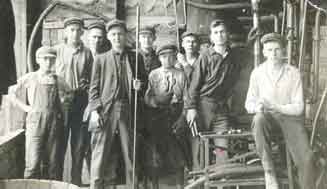| |


A
Dazzling History:
Fenton Art Glass
May 2006
By PHIL BERRY
Wonderful West Virginia
Magazine
In 1905, 25-year-old
Frank L. Fenton decided to try his hand at business. With only
$284.86 of seed money, Frank and his older brother John, launched
Fenton Art Glass Company in an abandoned glass factory building in
Martins Ferry, Ohio. At first, the brothers specialized in hand
painting decorations on glass blanks made by other glass
manufacturers. Unable to find a steady supply of glass, they soon
decided to produce their own. The Fentons moved their fledgling
company down the Ohio River to Williamstown, West Virginia, where
on January 2, 1907, they crafted their first piece of handmade
glass.
In time, Fenton's
glassmaking shops, furnaces, annealing lehrs (where the glass is
slowly cooled), sand-mixing devices, decorating studios, offices,
and packing areas all operated under one roof. Raw materials for
glassmaking arrived via the Baltimore & Ohio Railroad. In turn,
the company shipped its exquisite finished products in strawpacked
barrels - made at its on-site cooperage shop - by railroad and by
horse-drawn drays.
In 1909, John left to
start a new glass company in Millersburg, Ohio, but other members
of the Fenton family joined Frank in running the Williamstown
business. Frank's drive to create new and unusual colors quickly
vaulted Fenton Art Glass to the top of the handmade glass
industry. From 1905 to the 1920s, the company drew some of its
inspiration from the artists at world famous glass producers
Tiffany and Steuben.
Fenton Art Glass also
owes its early success to famous glass chemist Jacob Rosenthal,
also known as Uncle Jake, whose glass career began shortly after
the Civil War. Perhaps Rosenthal's most important contribution to
the young company was his role in the creation of iridescent
glass, known as carnival glass, which Fenton introduced in 1907,
Rosenthal's carnival glass, chocolate glass (sometimes called
caramel glass by antique dealers), and golden agate pieces are now
much-sought-after collector's items. Rosenthal also helped the
company persuade other talented glass workers to relocate to
Williamstown.
During the Depression
and World War II, Fenton shifted its focus from creating
decorative art glass to producing practical items such as mixing
bowls and tableware, all the while continuing to experiment with
new colors. They also introduced the Hobnail pattern line, which
would become the company's bread and butter for nearly four
decades.
Though Fenton Art Glass
survived the lean times of the 1930s and early 1940s, tragedy
struck in 1947 and 1948, when Frank, company vice
president-secretary and sales manager Robert C. Fenton, and
maintenance superintendent James E. Fenton all died, leaving the
enterprise in the hands of Frank M. Fenton, age 33, and Wilmer C.
(Bill) Fenton, age 25. Despite their youth, the second generation
of Fentons led the company through 30 years of rapid growth and
success, during a period when many of the country's handmade glass
producers closed up shop. Frank M. served as the company's
president and Bill as its vice president from 1948 to 1978, when
Frank M. became chairman of the board and Bill took over as
president. In 1986, Bill assumed the chairmanship of the board,
and Frank M.'s son, George W. Fenton, succeeded him as president.
Today, nine members of the Fenton family, along with more than 400
employees, continue the Fenton Art Glass legacy of producing
handmade art glass.
Stunning colors have
long been the signature of Fenton's glass pieces. The company uses
special ingredients - such as gold, manganese, and cobalt - to
achieve its rich hues. In addition to elegant colors, Fenton's
handpainted pieces are prized for their artistic detail. The
company's team of highly trained artists renders designs with a
mixture of enamel paint and finely crushed glass. The pieces are
then exposed to extremely high heat to fuse the paint to the
glass.
Fenton Art Glass is a
distinctive American product that continues to be collected
worldwide. To fully appreciate Fenton glass and the company's
100-year history, a tour of its factory, museum, and gift shop is
in order. Free factory tours give small groups of visitors an
intimate look at glassmaking in action. USA Today ranked the
Fenton tour among the country's top 10 factory tours, and Rand
McNally named Fenton in their 2006 Best of the Road guide. The
approximately 40-minute tours are typically available Monday
through Friday from 8:15 AM to 4:00 PM. Because tour hours are
subject to change, the company asks guests to please call ahead to
confirm tour times (304) 375-7772. For more information and for
gift shop and museum hours, visit the Web site:
www.fentongiftshop.com.
Fenton Art Glass also
operates a factory outlet store in Flatwoods that sells both
first-quality items and "preferred seconds," which have slight
imperfections. For more information, call (304) 765-3430.
[PHOTO CAPTION ABOVE]
An early photo of glassworkers in
the Fenton press shop Courtesy of Fenton Art Glass |